Unit 4 drilling systems and equipment
4.1. Remember the meaning of the following words and word combinations:
rotary rig - установка для вращательного бурения
torque - крутящий момент
annulus - затрубное (межтрубное) пространство
cuttings - шлам
lubricate - смазывать
polycrystalline diamond cutter – поликристаллический алмазный резец
cone - шарошка, коническая насадка
teeth - зубья, зубцы
discharge jet - выкидная струя
nozzle - насадка, сопло
bearing - подшипник, вкладыш подшипника
rate of penetration - скорость проходки
drill collar - утяжеленная бурильная труба (УБТ)
tension - напряжение, растяжение, упругость
buckling - прогиб, скручивание
suspend (hang) - подвешивать
kelly – квадрат, рабочая труба
saver - предохранительное устройство
saver sub – переводник с перенарезаемой резьбой в бурильной колонне
thread - резьба, нарезка
kelly bushing - вкладыш под рабочую штангу
rotary table - ротор
swivel - вертлюг
hoisting equipment - подъемное оборудование
spool - барабан лебедки; навивать, наматывать
crown block - кронблок
drum (draw works) - барабан (лебедка)
mast - мачта
reaming - расширение (скважины)
top drive system - система верхнего привода
drilling assembly – буровой снаряд (бурильная колонна со скваженным буровым
оборудованием и инструментом)
stand – 1) стеллаж, подставка; 2) свеча бурильных труб
rack - стапель; стеллажи для труб; зубчатый рельс
round trip - спуско-подъемный рейс, спуск-подъем инструмента
4.2. Read and translate the text using a dictionary:
DRILLING SYSTEMS AND EQUIPMENT
Whether onshore or offshore drilling is carried out, the basic drilling system employed in both cases will be the rotary rig (Fig. 3) and the following summarises the basic functions and parts of such a unit. Three basic functions are carried out during rotary drilling operations:
1) torque is transmitted from a power source at the surface through a drill string to the drill bit;
2) drilling fluid is pumped from a storage unit down the drill string and up through the annulus. This fluid will bring the cuttings created by the bit action to the surface, hence clean the hole, cool the bit and lubricate the drill string;
3) subsurface pressures above and within the hydrocarbon bearing strata are
controlled by the weight of the drilling fluid and by large valve assemblies at the surface.
We will now consider the rotary rig in operation, visiting all parts of the system starting at the drill bit.
The most frequently used bit types are the roller cone or rock bit (Fig.4) and the polycrystalline diamond cutter or PDC bit.
On a rock bit, the three cones are rotated and the attached teeth break the rock underneath into small chips (“cuttings”). The cutting action is supported by powerful jets of drilling fluid which are discharged under high pressure through nozzles located at the side of the bit. After some hours of drilling (between 5 and 25 hours depending on the formation and bit type), the teeth will become dull and the bearings wear out. Later on we will see how a new bit can be fitted to the drill string. The PDC bit is fitted with industrial diamond cutters instead of hardened metal teeth. This type of bit is becoming increasingly popular because of its better rate of penetration, longer life time and suitability for drilling with high revolutions per minute (rpm) which makes it the preferred choice for turbine drilling. The bit type selection depends on the composition and hardness of the formation to be drilled and the planned drilling parameters.
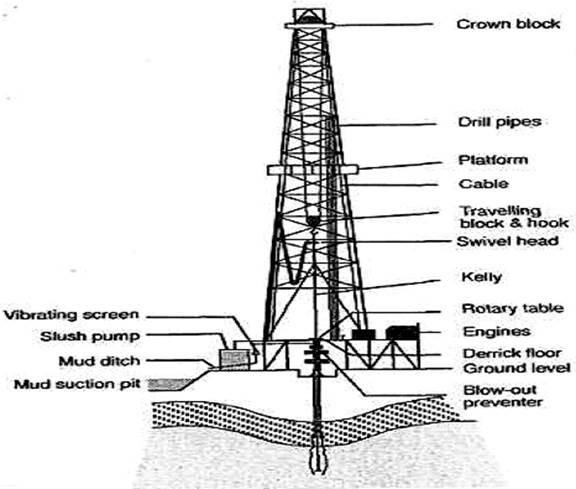
Figure 3. The rotary rig.
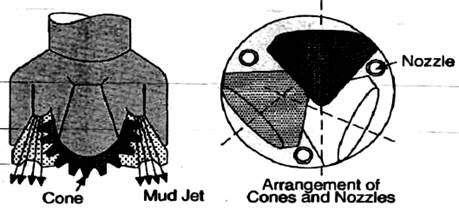
Figure 4. Roller cone bit (‘rock bit’)
Between the bit and the surface, where the torque is generated, we find the drill string (Fig. 5). While being mainly a means for power transmission, the drill string fulfils several other functions, and if we move up from the bit we can see what those are.
The drill collars are thick-walled, heavy lengths of pipe. They keep the drill string in tension (avoiding buckling) and provide weight onto the bit. Stabilisers are added to the drill string at intervals to hold, increase or decrease the hole angle. The bottom hole assembly (“BHA”) described so far is suspended from the drill pipe, made up of 30 foot long sections of steel pipe (“joints”) screwed together.

Figure 5. The Drill String.
The drill string is connected to the kelly saver sub. A saver sub is basically a short piece of connecting pipe with threads on both ends. In cases where connections have to be made up and broken frequently, the sub “saves” the threads of the more expensive equipment. The kelly is a six-sided piece of pipe which fits tightly into the kelly bushing which is fitted into the rotary table. By turning the latter, torque is transmitted from the kelly down the hole to the bit. It may take a number of turns of the rotary table to initially turn the bit thousands of meters down the hole.
The kelly is hung from the travelling block. Since the latter does not rotate, a bearing is required between the block and the kelly. This bearing is called a swivel. All components of the drill string are made of high quality steels. After the drilling has progressed for some time, a new piece of drill pipe will have to be added to the drill string. Alternatively, the bit may need to be replaced or the drill string has to be removed for logging. In order to “pull out of hole”, hoisting equipment is required. On a rotary rig this consists of the hook which is connected to the travelling block. The latter is moved up and down via a steel cable (“block line”) which is spooled through the crown block on to a drum (“draw works”). The draw works, fitted with a large brake, move the whole drill string up and down as needed. The derrick or mast provides the overall structural support to the operations described.
Most rigs are now fitted with a system whereby the drill string is rotated by a drive mechanism in the mast. Thus 90 foot sections can be drilled before connections need to be made, and the drill string can be rotated while pulling out of the hole in 90 foot sections. This improved system, which speeds up the operation and allows better reaming of the hole is known as top drive (Fig.6).
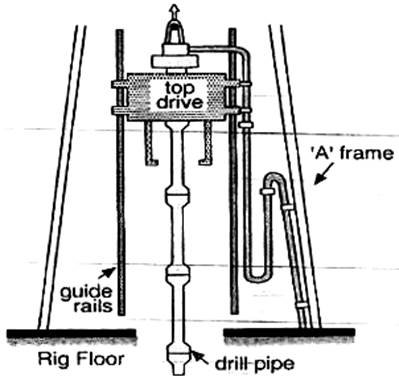
Figure 6. Top drive system.
For various reasons, such as to change the bit or drilling assembly, the drill string may have to be brought to surface. It is practice to pull stands consisting of 90ft sections of drill string and rack them in the mast rather than disconnecting all the segments. The procedure of pulling out of hole (‘POOH’) and running in again is called a round trip.
4.3. Translate the following word combinations into English. Use the text:
Буровая жидкость, источник энергии, разрушать породу, срок эксплуатации (службы), средство передачи энергии, толстостенный отрезок трубы, оказывать вес на долото, зависеть от, более подробно, высококачественная сталь, ускорять работу (операцию), а не, рассмотреть в действии, по разным причинам, состоять из.
4.4. Match the parts of the sentences given in columns A and B:
A B
1) On a rock bit a) consists of a hook which is connected to the
2) The drill collars traveling block
3) Stands b) consist of 90 ft sections
4) The kelly c) speeds up the operation and allows better
5) Hoisting equipment reaming of the hole
6) Top drive d) the attached teeth break the rock underneath
e) is a six-sided piece of pipe fitted into the
kelly bushing
f) are thick-walled, heavy lengths of pipe.
4.5. Match the words in list A with the words from list B to make word combinations. Translate them:
A. 1) valve 2) subsurface 3) roller 4) cutting 5) turbine
6) hole 7) bottom 8) kelly 9) traveling 10) rotary
B a) hole b) pressures c) drilling d) block e) assemblies
f) action g) bushing h) rig i) angle j) cone
4.6. Answer the following questions on the text:
1) What functions are carried out during rotary drilling operations?
2) What bit types are used most frequently?
3) How soon will the teeth become dull and the bearings wear out?
4) What is PDC bit fitted with? Why is it becoming increasingly popular?
5) What does a drill string consist of?
4.7. Translate the fourth abstract (beginning with the words “On a rock bit….) into Russian in writing.
4..8. Make up sentences using the following words:
a.it and of is so treatment knowledge sophisticated that preparation The requires drilling special fluid.
b. disposed, quantities friendly drilling are Large and so cheap of they should transported be and fluids environmentally pumped, .
4.9. Render the text “Drilling Systems and Equipment” either in Russian or in English.
UNIT 5 DRILLING FLUIDS
5.1. Remember the meaning of the following words and word combinations:
screen - фильтр; сито
shale shaker - вибрационное сито
desander - пескоотделитель
desilter - обессоливатель
hydrocyclone - гидроциклон
viscosity - вязкость
pumpable - способный к перекачке
swelling - обогащение нефти газом; набухание, вспучивание
clay - глина
benign - благотворный
logging - каротаж; скважинные исследования
mud invasion - закачка бурового раствора
blowout preventer - превентор для герметического закрытия скважины
в случаях фонтанирования
hydrostatic head – гидростатический напор
permeable formations - проницаемые пласты
kick - вызвать фонтанирование
well bore - ствол скважины
sealing elements - уплотнители
choke - фонтанный штуцер
hook load - нагрузка на крюк
roughneck - рабочий буровой бригады
single – однотрубная свеча (бурильных труб)
derrick man - верховой рабочий
fishing - ловильные работы в скважине
maintenance crew – бригада техобслуживания
tool pusher - буровой мастер
5.2 Read and translate the text using a dictionary:
DRILLING FLUIDS
Earlier on when we described the cutting action of the drill bit we learned about the drilling fluid or mud. The mud cools the bit and also removes the cuttings by carrying them up the hole outside the drill pipe. At the surface the mud runs over a number of moving screens, the shale shakers (Fig. 7) which remove the cutting for disposal. The fine particles which pass through the screens are then removed by desanders and desilters, usually hydrocyclones.
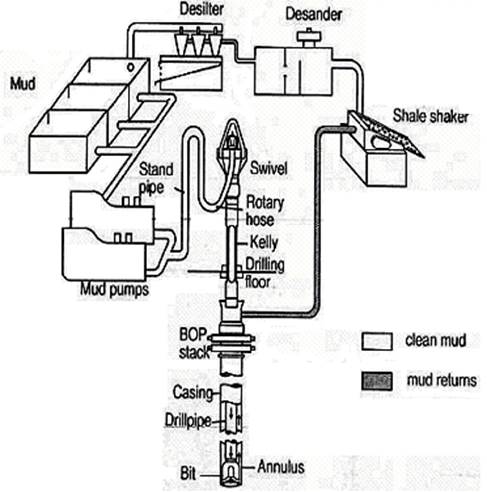 |
Figure 7. Mud circulation system.
Having been cleaned, the mud is transferred into mud tanks, large treatment and storage units. From there a powerful pump brings the mud up through a pipe {standpipe) and through a hose connected to the swivel (rotary hose) forcing it down the hole inside the drill string. Eventually the cleaned mud will exit again through the bit nozzles. Originally, “mud” was made from clay mixed with water, a simple system. Today the preparation and treatment of drilling fluid has reached a sophistication which requires specialist knowledge. The reason for this becomes clear if we consider the properties expected.
In order to effectively lift the cuttings out of the hole a certain viscosity needs to be achieved, yet the fluid must remain pumpable. If the mud circulation stops, for instance to change the bit, the mud must gel and any material suspended in it must remain in suspension to avoid settling out at the bottom of the hole. It has to be stable under high temperatures and pressures as well as at surface conditions. Mud chemicals should not be removable by the mud cleaning process. Drilling fluids have to be capable of carrying weighing material such as barites in order to control excessive formation pressures. They have to be compatible with the formations being drilled, e.g. they should prevent the swelling of formation clay and not permanently damage the reservoir zone. Last but not least, since these fluids are pumped, transported and disposed in large quantities they should be environmentally friendly and cheap!
Most drilling fluids are usually made up using water and called water based muds (“WBM”). Another frequently employed system is based on oil, oil based mud (“OBM”). The advantage of OBM is better lubrication of the drill string, compatibility with clay or salt formations and a much higher rate of penetration. Diesel fuel is usually used for the preparation of OBM. During operations, large quantities of contaminated cuttings were formerly disposed of onto the sea-bed. This practice is no longer considered environmentally acceptable and the cost of adequate disposal of OBM has reduced its use.
New mud compositions and systems are continuously being developed, for instance currently the industry is introducing synthetic drilling fluids which rival the performance of OBM but are environmentally benign.
The choice of drilling fluid has a major impact on the evaluation and production of a well. Later in this section, we will investigate the interaction between drilling fluids, logging operations and the potential damage to well productivity caused by mud invasion into the formation.
An important safety feature on every modern rig is the blowout preventer (“BOP”). As discussed earlier on, one of the purposes of the drilling mud is to provide a hydrostatic head of fluid to counterbalance the pore pressure of fluids in permeable formations. However, for a variety of reasons the well may ‘kick’, i.e. formation fluids may enter the well bore, upsetting the balance of the system, pushing mud out of the hole, and exposing the upper part of the hole and equipment to the higher pressures of the deep subsurface. If left uncontrolled, this can lead to a blowout, a situation where formation fluids flow to the surface in an uncontrolled manner.
Blowout preventers are a series of powerful sealing elements designed to close off the annular space between the pipe and the hole through which the mud normally returns to the surface. By closing off this route, the well can be ‘shut in’ and the mud and/or formation fluids are forced to flow through a controllable choke, or adjustable valve. This choke allows the drilling crew to control the pressure that reaches the surface and to follow the necessary steps for 'killing' the well, i.e. restoring a balanced system. Figure 8 shows a schematic of a typical set of blowout preventers.
Blowout preventers are opened and closed by hydraulic fluid stored under a pressure of 3000 psi in an accumulator, often referred to as a ‘Coomy’ unit.
All drilling activity will be carried out by the drill crew which usually works eight or twelve hour shifts. Instrumentation will enable them to monitor and control the drilling parameters, specifically:
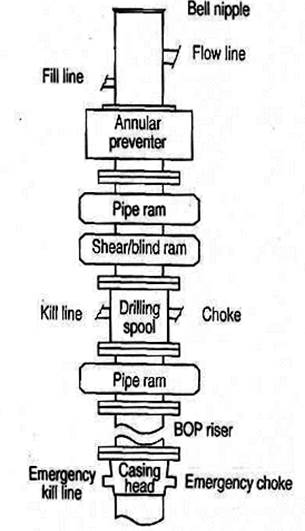
Figure 8. Schematic of a blowout preventer (BOP).
· hook load
· torque in drill string
· weight on bit (WOB)
· rotary speed (RPM)
· pump pressure and rate
· rate of penetration (ROP in min/ft)
· mud weight in and out of the hole
· volume of mud in the tanks.
The roughnecks work on the rig floor, adding singles, round tripping etc. The derrick man handles the pipe up in the mast. In addition to the drilling crews, drilling operations require a number of specialists for mud engineering, logging, fishing etc., not to forget maintenance crews, cooks and cleaning staff. It is not uncommon to have some 90 people on site. The operation is managed on site by a drilling engineer or “tool pusher”.
5.3. Translate the following word combinations into English. Use the text:
Ожидаемые свойства, достичь вязкости, циркуляция бурового раствора, оставаться во взвешенном состоянии, быть совместимым с пробуриваемым пластом; последнее по порядку, но не по важности; буровой раствор на водной основе, больше не, оказывать большое влияние, эксплуатационная скважина, исследовать взаимодействия, важная особенность, по разным причинам, приводить к выбросу, перекрыть движение (маршрут), достичь поверхности.
5.4. Match the words in list A with the words from list B to make word combinations. Translate them:
A. 1) specialist 2) mud 3) formation 4) water based 5) blowout
6) well 7) drilling 8) hook 9) rotary 10) assistant
B. a) bore b) speed c) knowledge d) pressure e) driller
f) crew g) load h) circulation i) muds j) preventer
5.5. Fill in the gaps to make the following sentences complete using one of the verbs from the list below:
a) flows b) requires c) removes d) allows e) brings f) stops
g) reaches h) cools i) runs over j) has k) is l) needs
1) The mud ________ the bit and _________ the cuttings by carrying them up the hole outside the drill pipe.
2) At the surface the mud ________ a number of moving screens which remove the cutting for disposal.
3) From mud tanks a powerful pump _______ the mud up through a pipe and a hose connected to the swivel.
4) Sophistication of drilling fluids ____________ specialist knowledge.
5) To lift the cuttings out of the hole a certain viscosity __________ to be achieved.
6) If mud circulation ________ to change the bit, the mud must gel.
7) The advantage of OBM _____ better lubrication of the drill string.
8) The choice of drilling fluid _______ a major impact on the evaluation and
production of a well
9) In a situation of a blowout formation fluid _______ to the surface in an uncontrolled manner.
10)The choke ______ the drilling crew to control the pressure that _______the
surface valve.
5.6. Define the Tense forms used in the following sentences. Translate them.
1) Having been cleaned the mud is transferred into mud tanks.
2) The cleaned mud will exit again through the bit nozzles.
3) Today preparation and treatment of drilling fluid has reached a sophistication.
4) The mud has to be stable under high temperatures and pressures as well as at
surface conditions.
5) Since drilling fluids are pimped, transported and disposed in large quantities they
should be environmentally friendly and cheap.
6) New mud compositions and systems are continuously being developed.
5.7. Answer the following questions on the text:
1) In what way was “mud” originally made? 2) What happens if the mud circulation stops? 3) What do drilling fluids have to be compatible with? 4) How are most drilling fluids usually made up? 5) What is an important safety feature on every modern rig? 6) What is one of the purposes of the drilling mud? 7) What does a situation of a blowout mean? 8) What are blowout preventers designed for?
9) What are blowout preventers opened and closed by?
5.8. Translate the fifth abstract of the text into Russian in writing.
5.9. Make up sentences using the following words:
a.host assessment is out as a first impact the to step the legal carried requirements of meet country An environmental.
b. the coated rig is lining cleared of leveled site and with First plastic vegetation,.
5.10. Render the text “Drilling Fluids” either in Russian or in English.
UNIT 6 SITE PREPARATION
6.1. Remember the meaning of the following words and word combinations:
liability - ответственность
air emission - выброс воздуха
effluent and waste disposal – размещение сточных вод и пустых пород
emergency response – реакция на критические обстоятельства
site survey - обследование места
restriction - ограничение
constraint - стеснение, скованность
layout – план, набросок
pit - яма
auxiliary - вспомогательный
level - выравнивать
ensure - обеспечивать, гарантировать
trap - улавливать в ловушку
wreckage - обрушение
reveal - обнаруживать
escape from - мигрировать, улетучиваться
sand lenses - песчаные линзы
leakage - утечка
chimney - труба
overburden - наносы, покров
bore - выбуривать
load bearing capacity - допускаемая нагрузка, грузоподъемность
footprint – след, отпечаток
6.2. Read and translate the text using a dictionary:
SITE PREPARATION
Once the objectives of the well are clear, further decisions have to be made. One decision will be where to site the drilling location relative to the subsurface target and which type of rig to use.
If no prior drilling activities have been recently carried out in the area, usually an environmental impact assessment (EIA) will be carried out as a first step. An EIA is usually undertaken to:
· meet the legal requirements of the host country
· ensure that the drilling activity is acceptable to the local environment
· quantify risks and possible liabilities in case of accidents
An EIA may have to include concerns such as:
* protection of sites of special interest (e.g. nature reserves, archaeological sites)
* noise control in built-up areas
* air emission
* effluent and waste disposal
* pollution control
* visual impact
* traffic (rig transport and supply)
* emergency response (e.g. fire, spills)
Onshore Sites
A site survey will be carried out, from which a number of parameters can be established, e.g. carrying capacity of the soil at the planned location, possible access routes, surface restrictions like built-up areas, lakes, nature reserves, the general topography, possible water supplies. The survey will allow the adequate preparation of the future location. For instance, onshore in a swamp area the soil needs to be covered with support mats.
The size of the rig site will depend on operational requirements and possible constraints imposed by the particular location. It will be determined by:
· the type of derrick or mast; it must be possible to rig this up on site
· the layout of the drilling equipment
· the size of the waste pit
· the amount of storage space required for consumables and equipment
· the number of wells to be drilled
· whether the site will be permanent (in case of development drilling)
A land rig can weigh over 200 tons and is transported in smaller loads to be assembled on site.
Prior to moving the rig and all auxiliary equipment the site will have to be cleared of vegetation and levelled. To protect against possible spills of hydrocarbons or chemicals the surface area of a location should be coated with plastic lining and a closed draining system installed. Site management should ensure that any pollutant is trapped and properly disposed of.
If drilling and service personnel require accommodation at the well site a camp will need to be constructed. For safety reasons the camp will be located at a distance from the drilling rig and consist of various types of port cabins. For the camp, waste pits will be required, access roads, parking space and drinking water supplies.
Offshore Sites
The survey requirements will depend on rig type and the extent of the planned development e.g. single exploration well or drilling jacket installation. Atypical survey area is some 4 km by 4 km centred on the planned location. Surveys may include
1) sea-bed survey:
Employing high resolution echo-sounding and side scan sonar imaging, an accurate picture of the sea bottom is created. The technique allows the interpreter to recognize features such as pipelines, reefs, and wreckage.
Particularly if a jack-up rig is considered, an accurate map of these obstructions is required to position the jack-up legs safely. Such a survey will sometimes reveal crater-like structures (“pock marks”), which are quite common in many areas. These are the result of gas escape from deeper strata to the surface and could indicate danger-from shallow-gas accumulations.
2) shallow seismic:
Unlike ‘deep’ seismic surveys aimed at the reservoir section the acquisition parameters of shallow surveys are selected to provide maximum resolution within the near surface sedimentary layers (i.e. the top 800 m.) The objective is to detect indications of shallow gas pockets. Gas may be trapped within sand lenses close to the surface and may enter the borehole if penetrated by the drill bit, resulting in a potential blowout situation. Gas chimneys are large scale escape structures where leakage from a reservoir has created a gas charged zone in the overburden.
3) soil boring:
Where planned structures require soil support, e.g. drilling jackets or jack-up rigs, the load bearing capacity has to be evaluated (just like on a land location). Usually a series of shallow cores are taken to obtain a sample of the sediment layers for investigation in a laboratory.
Particularly for jack-up rigs, site surveys may have to be carried out prior to each reemployment to ensure that the rig is positioned away from the previously formed ‘footprints’ (depressions on the sea-bed left by the jack-up legs on a previous job).
6.3. Translate the following word combinations into English. Use the text:
Экологическая экспертиза, удовлетворять требованиям, подъездные пути, провести осмотр местности, установить параметры, запас воды, эксплуатационное бурение, собирать на месте, обслуживающий персонал, парковка, очистить от растительности, разведочная скважина, точная картина, в отличие от, осадочные слои, обнаружить признаки.
6.4. Match the words in list A with the words from list B to make word combinations. Translate them:
A. 1) noise 2) emergency 3) access 4) nature 5) waste
6) land 7) survey 8) blowout 9) swamp 10) site
B. a) reserves b) rig c) management d) requirement e) control
f) routes g) pit h) area i) situation j) response
6.5. Choose the only correct variant (A, B or C) to fill in the gaps in the following sentences:
1) EIA will be carried out as a _________ step if there were no prior drilling activities.
a) second b) third c) first
2) In a swamp area the soil needs to be covered with __________.
a) access routes b) support mats c) storage space
3) A land rig can weigh over __________ and is transported in smaller loads to be
assembled on site.
a) 200 kg b) 200 tons c) 2000 kg
4) For safety reasons the camp will be located ________ the drilling rig.
a) at a distance from b) close to c) far away from
5) Crater-like structures are the result of _________ from deeper strata to the surface.
a) water escape b) oil escape c) gas escape
6) Gas may be trapped within ________ close to the surface and may enter the
borehole if penetrated by the drill bit.
a) gas chimneys b) sand lenses c) waste pits
7) Site surveys have to be carried out _________ each reemployment of jack-up rigs.
a) prior to b) after c) simultaneously with
6.6. Answer the following questions on the text:
1) What does EIA mean? 2) What will the site survey allow? 3) What is necessary to do prior to moving the rig and auxiliary equipment? 4) What is done if personnel require accommodation at the well site? 5) What will the survey requirements depend on? 6) What may surveys include?
6.7. Translate the first three abstracts of the text into Russian in writing.
6.8. Make up sentences using the following words:
a.bit top is with formations a large soft hole diameter The designed usually to drill drilled.
b. between rocks section of more An consolidated is usually section drilled the consisting top hole and the reservoir intermediate.
6.9. Render the text “Site Preparation” either in Russian or in English.
UNIT 7 DRILLING TECHNIQUES
7.1. Remember the meaning of the following words and word-combinations:
consider – рассматривать
total depth (TD) – 1) общая глубина, проектная глубина; 2) конечная глубина
shallow section – неглубокая часть (скважины), неглубокое расстояние
intermediate section – промежуточная часть (скважины)
reservoir - коллектор, продуктивные пласт; нефтеносный, газоносный пласт
refer to – (зд.) называть
top hole – верхняя скважина
unconsolidated sediments – неуплотненные осадочные породы
consolidated – уплотненный
formation strength – прочность пласта
accordingly – соответственно
main objective = prime objective = target – основная цель
hence - следовательно
ensure – гарантировать
productive interval – продуктивный горизонт, продуктивный интервал
damage – повреждать
commence drilling – начинать бурение
in a land location – (зд.) на суше
cemented cellar – зацементированная устьевая шахта (скважины)
conductor – кондуктор ( первая колонна обсадных труб)
stove pipe – легкая клёпаная труба большого диаметра (используемая как
кондуктор)
pile – (зд.) забивать
accommodate – вмещать, размещать
Christmas tree – фонтанная арматура, фонтанное устьевое оборудование
seal – сальниковое уплотнение , сальник, изолирующий слой
valve – клапан; вентиль; задвижка
once – как только
drill bit – буровое долото
spud – забуривать скважину, приступать к бурению (ствола скважины)
roller cone – 1) коническая шарошка, 2) шарошка долота
treat – очищать
remove – удалять
removal – удаление
mud circulation system – система циркуляции бурового раствора
rate of penetration – механическая скорость бурения, скорость проходки
reduce – снижаться, сокращаться
alleviate – облегчать, смягчать
hole opener – буровой расширитель
log – проводить каротажные операции
logging tools – каротажный прибор, скважинный зонд (для каротажа)
accurate directional drilling – точное направленное бурение
surface casing – кондуктор (первая колонна обсадных труб)
hole collapse – обрушение скважины
shallow aquifer – неглубокий водоносный пласт
deviation angle – угол отклонения
water bearing - содержащий воду, водоносный
influx – приток (воды, воздуха, нефти, газа в скважину)
integrity – целостность, сохранность
well bore – скважина
mature field – давно разрабатываемое месторождение
depletion – истощение, снижение
impair the formation – повредить пласт
defer the production – замедлять добычу
sufficient – достаточный
evaluate the formation – оценить пласт
7.2 Read and translate the text using a dictionary:
DRILLING TECHNIQUES
If we consider a well trajectory from surface to total depth (TD) it is better to look at the shallow section and the intermediate and reservoir sections separately. The shallow section, usually referred to as top hole consists of rather unconsolidated sediments, hence the formation strength is low and drilling parameters and equipment have to be selected accordingly.
The reservoir section is more consolidated and is the main objective to which the well is being drilled, hence the drilling process has to ensure that any productive interval is not damaged.
Top Hole Drilling
A base from which to commence drilling is required for the very first section of the borehole . In a land location this will be a cemented "cellar" in which a conductor or stove pipe will be piled prior to the rig moving in. The cellar will accommodate the 'Christmas tree' (an arrangement of seals and valves) (Fig. 9).
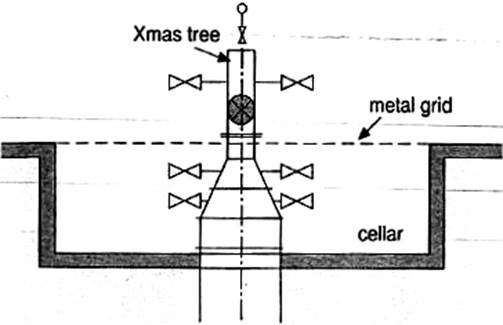
Figure 9. Cellar with Xmas tree on a land location.
As in the construction industry, piling of the conductor is done by dropping weights onto the pipe or using a hydraulic hammer until no further penetration occurs. Once the drill bit has drilled below the conductor the well is said to have been spudded.
The top hole will usually be drilled with a large diameter bit of between 23" and 27" diameter. The drill bit (roller cone type) will be designed to drill soft formations. As a result of the hole diameter and the rapid penetration rate, vast quantities of drilled formation will have to be treated and removed from the mud circulation system.
Often the rate of penetration will be reduced to allow adequate removal of cuttings and conditioning of mud. In some cases the problem is alleviated by first drilling a hole with a smaller diameter bit (12 1 /4") and later redrilling the section to the required size using a hole opener. This is essentially a larger diameter drill bit above the smaller diameter bit. Hole openers are also run if the hole has to be logged (most logging tools are not designed for diameters above 17 1/2") and if accurate directional drilling is required.
A surface casing is finally cemented to prevent hole collapse and protect shallow aquifers.
